Welcome to NE Where, a weekly travel-focussed journal for curious people. This piece (which is one from an assignment Mark and I undertook a few years ago) is free for everyone, and paying subscribers have access to an additional gallery of photographs. For less than $1 a week paying subscribers also have unlimited access to NE Where’s growing archive, which is packed with inspiration and ideas for an unforgettable trip to Bali, stories about exceptional women, and other tales about interesting people and places. Thank you for joining me on this journey!

Listen to this story, instead of reading it:
Dear NE-One
About an hour’s drive south of the Galana River there is an area in Kenya’s Tsavo East National Park that is as empty and as desolate as you could ever imagine Africa to be. There is only one tree – too far down the road to tell exactly what it is; an acacia of some sort, perhaps – that shows any sign of life: its leaves offer cool respite from the severity of a stark landscape. Scattered from its base and across the dusty, light-ochre earth are tatty shrubs and the dull grey spines of what once were grasses. But as is so often the case in Africa, the more you look, the more you see, and from this landscape of nothing emerges a tale of life, of survival and ultimately of abundance.

That is how it was on our first morning in Tsavo East, when we sat on the roof of our battered 1970s Land Cruiser. We’d named her Katy-P, from the letters on her number plate, and through our Tsavo journey we would spend many happy hours on her roof, feasting from yoghurt cartons as the East African mornings erupted into day.
We are already a few weeks into an assignment for Fodor’s, updating the Kenya chapter of one of their guidebooks, and Mark and I had slipped effortlessly into a daily routine: waking just after sunrise, we’d stoke the fire to brew coffee as we broke camp, and as soon as Katy-P was packed we’d head off into the day. Destination: relatively unknown. What we did know, however, was that we planned to drive border to border, south to north, across Tsavo West and Tsavo East – together Kenya’s largest national park.
The Tsavos straddle the Trans Africa Highway between Nairobi and Mombasa. They sprawl across 21,000 remote square kilometres, and cover almost four percent of Kenya’s land. Tsavo West, the smaller and less visited of the two parks, is where our journey began. We’d entered the park at Chyulu Gate and over almost two days we explored roads more and more isolated, until we reached Lake Jipe, on the Tanzania border. It was there, one morning in that quiet southeast corner of the park, that we caught fleeting glimpses of the snowy peak of Kilimanjaro, which is slowly melting away into the waters of the lake.

Of all the roads we travelled, it was the gentle stretches along Lake Jipe that were the most beautiful. The red dust that Tsavo is so well known for filters from under dry savannah scrub into sweet grasses and down to the verdant reeds that fringe the lake’s shores. From there the land stretches back and up into Tanzania, into the North Pare Mountains. The sheer abundance of wildlife around Jipe – large herds of elephant and waterbuck, eland, gemsbok, impala, zebra, baboons – was startling and it was obvious from their skittish reaction to Katy-P that they’d not yet been habituated to visitors.
Mark and I spent a very content morning – the most memorable of our journey, we’ve agreed – sipping cold coffee on the roof of Katy-P, along the shore of Lake Jipe and with a view of Kilimanjaro far behind us. We were captivated for more than an hour as a herd of elephants, the red dust of Tsavo forever etched into their hides, engaged in a silent, mysterious ritual – perhaps evicting a young bull from the herd – before crossing the water to an island in the lake.
But as we sat in the dry emptiness of our first morning in Tsavo East, the gentle solace of Jipe was several days and many ecosystems behind us. We’d gotten off to a late start and the sun already began to burn our skin through the thin morning clouds. As the shadows cast by ripples of sand shortened, and as our eyes grew accustomed to the abrasive landscape, animals started to emerge from what initially appeared to be vast plains of nothing. A lone giraffe – hesitant at first and dwarfed by the sky – lolloped from a minor dust-storm in that awkward, tall-horse way. Some of the distant shrubs, it turned out, were scratching guineafowls, and a herd of zebras emerged from almost nowhere, walking in single file. There were more trees out there, we realised, and broken stumps too. Elephant damage from years ago, perhaps?
The Tsavo parks are well known for their elephant sagas. It’s become a tale of war, peace and rehabilitation. In the late 1960s there were about 35,000 elephants in the Tsavo area and by the early 1970s, due to trophy hunting and drought, the elephant population had declined to around 17,000. That figure dropped even further through to the late Eighties – according to the organisation Tsavo Elephant Research, the population dropped as low as 6,200, and it’s said that by 1989 three elephants were being slaughtered in Tsavo every single day. It was during that year that an international ban was placed on the trade of ivory, and Dr Richard Leakey, then the director of what became Kenya Wildlife Service, launched an aggressive war against poachers. While poaching is still a problem, the campaign was a success and the numbers of elephant carcasses found through the Nineties plummeted. Although far from what it once was, Tsavo’s elephant population is recovering. In 2007 the population stood at around 13,000; by 2021 it had increased to just under 15,000.
The Galana River, which slices Tsavo East very neatly into north and south, became an unofficial boundary for poachers. North of the Galana lies almost two-thirds of the 12,000-square-kilometre park, an area that, when we visited, was essentially off-limits to visitors; this section of the park has been mapped with names like Hand-Grenade Valley and Elephant’s Bone Corner. Up here, we would discover, there is an unsettling, eerie feeling – as if you’re approaching the frontlines of a conflict zone. Even the regal baobabs seem a little frazzled by the tension.

South of the Galana, however, there is a tangible sense of belonging, of tolerance, and of peace. We witnessed that on our first morning in Tsavo East.
The lone giraffe crossed in front of us and moved towards the herd of zebras that had gathered at the waterhole. That was why we’d stopped there, in the middle of nothing: there was a windmill. We’d hoped that if we took our time over a rooftop breakfast, one or two animals would make their way towards us to drink.
I will always be astounded by how silently elephants can move, and how discretely they morph from shadows into sight. That morning, it was almost as if by magic that the herd of six elephants approached the waterhole and they took the zebras – as well as us – by surprise. They moved without sound, walking side by side, when suddenly their ears flared and their heads raised slightly, in mock charge. Within an instant the zebras, all 15 of them, scattered in a panic of legs and water and dust. Their hooves thudded and kicked and their bodies turned at dangerous angles, desperate to find an open path out. But their fright didn’t last long. All that the elephants had wanted was to clear a space to drink and as soon as they were gathered around the water, the zebras wandered back; fresh ochre dust clinging to the edge of their manes. The peace of the morning settled once more.

We indulged in a few more rooftop breakfasts in Tsavo, with each morning bringing something different: leopard spoor, grasslands, a lion’s roar, vast plains, scraggly trees, circling vultures, lush vegetation; and always – always – there was a sense of quiet settled in the land’s red soil. It would take four days to wash the last particles of Tsavo’s red dust from my skin. And still – months on – I’d find traces of it in my notebook, in the stitching of my camera bag and at the bottom of my backpack. And every time I came across another grain, it took me back those 2,000km travelled in Katy-P, and it reminded me to slow down and to look further. Because, as I learnt on those rooftop mornings, there is so much depth to stillness.
Until next weekend
Narina x
PS here’s a gallery of images, from Tsavo East and Tsavo West:
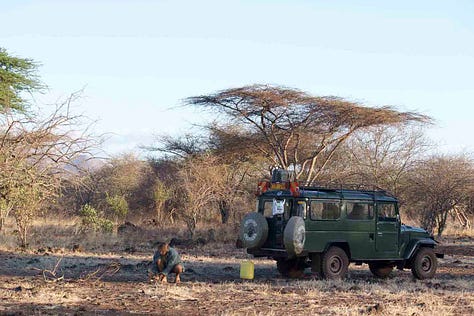
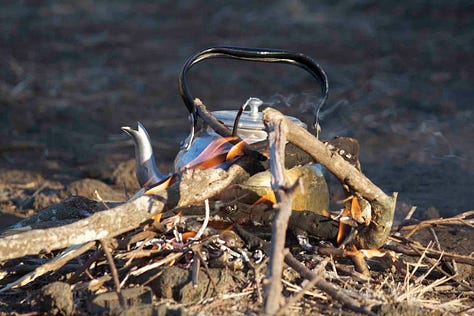
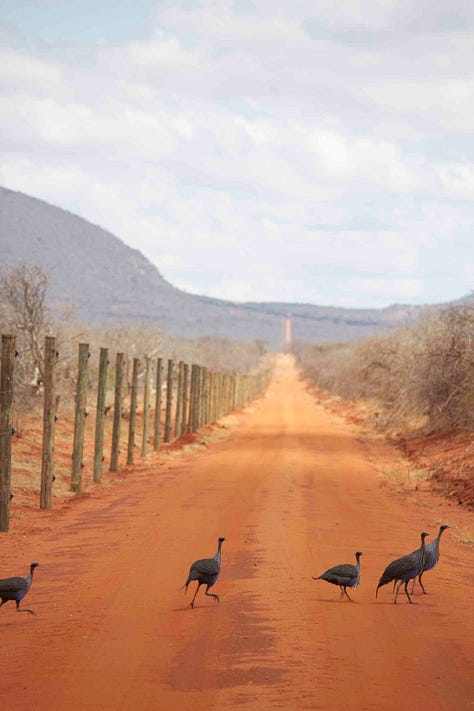
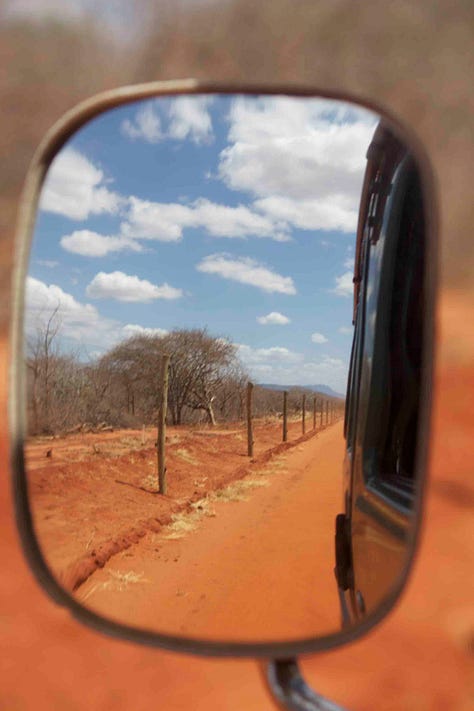

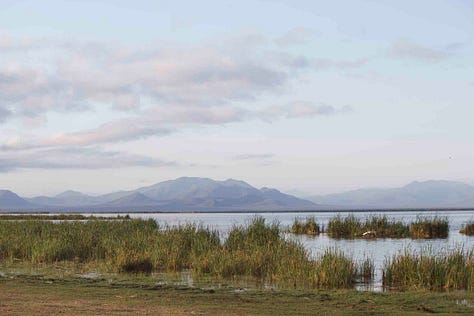
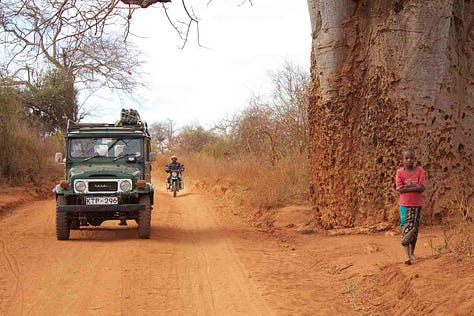





That looks and sounds like an incredible place. Very much hope to make it to Africa in the near future.
Great memories! Being on the road (off the road mostly actually) on that trip through Kenya was one of the best trips I've ever done. Let's do it AGAIN sometime!